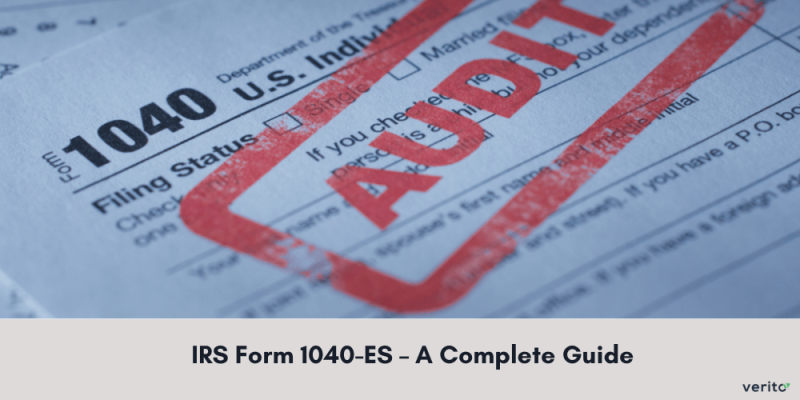IRS Form 1040-ES – A Complete Guide
Executive Summary
- IRS Form 1040-ES is required for anyone expecting to owe $1,000 or more in taxes not covered by withholding.
- Quarterly estimated tax payments are due in April, June, September, and January.
- Self-employed professionals, small business owners, and investors are the most common filers.
- Missing deadlines or underpaying can result in IRS penalties.
- Purpose-built IT solutions like Verito help tax and accounting firms maintain compliance and operational continuity during peak tax periods.
What Is IRS Form 1040-ES and Why Does It Matter?
IRS Form 1040-ES is the official document used by individuals to calculate and pay estimated taxes on income that isn’t subject to withholding. This includes self-employment earnings, investment income, rental income, alimony, and other non-wage sources. If you expect to owe at least $1,000 in taxes after accounting for withholding and credits, and your withholding or credits fall short of certain IRS thresholds, you are required to use this form to make quarterly payments.
Why is this important?
Failing to pay enough tax throughout the year using IRS Form 1040-ES can result in penalties and interest. For tax and accounting professionals, helping clients stay compliant with estimated tax requirements is a core service and one that depends on reliable, secure access to client data and tax software.
Who Needs to File IRS Form 1040-ES?
Common Scenarios Requiring Estimated Tax Payments
You need to file IRS Form 1040-ES if you receive income that isn’t subject to automatic tax withholding. This typically includes:
- Self-employed individuals and freelancers: No employer withholds taxes, so you must pay directly.
- Small business owners: Profits from your business are not subject to withholding..
- Independent contractors: Payments received are gross, with no taxes withheld.
- Investors: Income from dividends, interest, or capital gains is usually not withheld.
- Recipients of alimony or other non-wage income: These payments may require estimated tax payments if they make up a significant portion of your income.
If you expect to owe at least $1,000 after subtracting withholding and refundable credits, and your withholding/credits are less than 90% of your current year’s tax or 100% of last year’s tax, you must file IRS Form 1040-ES.
Similarly when and why would you need IRS Form W-9.
Are There Exceptions to Filing Form 1040-ES?
Not everyone with non-wage income needs to file IRS Form 1040-ES. You may be exempt if:
- Your withholding covers your total tax liability
- You had no tax liability last year and were a U.S. resident all year
- You expect enough refundable credits to cover your tax
Understanding these exceptions helps you avoid unnecessary estimated tax payments and stay compliant with IRS Form 1040-ES guidelines.
When Are Estimated Tax Payments Due?
Estimated tax payments via IRS Form 1040-ES are made in four installments throughout the year. The deadlines are:
| Quarter | Payment Due Date | Income Covered |
| 1st | April 15 | January 1 – March 31 |
| 2nd | June 15 | April 1 – May 31 |
| 3rd | September 15 | June 1 – August 31 |
| 4th | January 15 (next year) | September 1 – December 31 |
If a due date falls on a weekend or holiday, it moves to the next business day. Filing your annual return by January 31 and paying the full balance allows you to skip the January 15 IRS Form 1040-ES payment.
Get key insights into the role and functions of Internal Revenue Service (IRS).
How Do You Calculate and Pay Estimated Taxes?
Step-by-Step Process
- Estimate your total expected income for the year.
- Calculate your expected tax liability using the IRS worksheet included with Form 1040-ES.
- Subtract any expected withholding and refundable credits.
- Divide the remaining tax by four to determine your quarterly payments.
- **Submit payments online, by phone, or by mail using the payment vouchers provided with Form 1040-ES.
Example: A CPA with $120,000 in self-employment income, no withholding, and $10,000 in credits would estimate their total tax, subtract credits, and divide the remainder into four equal payments.
What Happens If You Miss a Payment or Underpay?
Missing a payment or underpaying can result in IRS penalties and interest. The IRS calculates penalties based on the amount underpaid and the length of time the payment is late. For tax professionals, helping clients avoid these penalties is a key value-add—and it depends on having uninterrupted access to tax software and client data.
How Verito Supports Tax and Accounting Firms
Tax and accounting professionals rely on continuous, secure access to their applications and data to prepare and file IRS Form 1040-ES and other tax documents accurately and on time.
- VeritSpace: Dedicated private server hosting for QuickBooks, Drake, Lacerte, and more, with 99.999% uptime, daily backups, and secure remote access.
- VeritGuard: Proactive managed IT services with 24/7 U.S.-based support, threat monitoring, and built-in compliance with IRS and FTC standards.
- VeritComplete: A unified platform combining hosting and IT management for seamless, secure operations.
Why does this matter?
Downtime or security breaches during tax season can disrupt client service and risk compliance. Verito’s SOC 2 Type II compliant infrastructure and expert support help firms eliminate these risks, so you can focus on serving clients not fixing tech.
Comparison: Verito vs. Typical Hosting Providers
| Feature | Verito (VeritSpace/VeritGuard) | Typical Hosting Provider |
| Uptime Guarantee | 99.999% | 99.9% or less |
| Data Isolation | Dedicated private servers | Shared environments |
| Compliance Standards | SOC 2 Type II, IRS, FTC | Varies |
| Support Availability | 24/7 U.S.-based, expert | Limited or offshore |
| Migration Speed | Under 72 hours | 1 week or more |
| Pricing Transparency | No surprise fees | Often variable |
Key Takeaways
- IRS Form 1040-ES is essential for anyone with significant non-wage income.
- Quarterly payments help you avoid IRS penalties and smooth out your tax liability.
- Accurate, timely payments depend on reliable access to your tax software and data.
- Verito’s dedicated hosting and managed IT services are designed to keep your firm compliant, secure, and always operational
Ready to simplify your tax technology and compliance?
Ready to simplify tax compliance with secure, uninterrupted access to IRS Form 1040-ES workflows? Visit Verito.
















1 comment
Comments are closed.